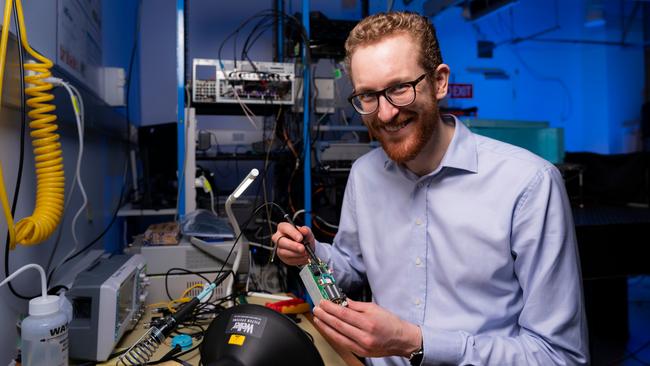Uni team on the verge of next tech revolution
ANU scientist Andrew Horsley is creating the seemingly impossible. He’ll put a quantum computer in the palm of your hand.

In a laboratory at the Australian National University physicist Andrew Horsley believes that he and his team are creating the next technological revolution — a quantum computer which you can hold in the palm of your hand.
Dr Horsley, the CEO of the company Quantum Brilliance which was spun out from the ANU two years ago, says that quantum computing is on the edge of a revolution similar to the one which classical computing had in the 1960s when big mainframe computers were rapidly overtaken by microprocessors, leading to the tiny devices we carry around today.
He and his team use painstakingly fabricated synthetic diamonds to create the qubits, or bits of quantum information, which are at the heart of a quantum computer.
READ MORE:ANU plan to shut Nobel winning arm | Small unis are beautiful, say students | Untold wealth from innovation | Recovery boost for unis |
The most revolutionary thing about their work is that — unlike other quantum computers which operate at near the absolute zero temperature of minus 273 degrees and require a roomful of equipment to keep them going — it will operate at room temperature and can fit in a lunch box.
“A key starting point is that we use diamond,” Dr Horsley said. “Diamond has a lot of extreme qualities which enable you to go to room temperature.”
One of them is that diamond is a strong and rigid material which helps protect the delicate qubits from outside interference. Another is that it can be laced with impurities — precisely placed atoms of nitrogen as well as empty spaces where there are no atoms — which give the material its quantum qualities.
Synthetic diamonds are already used in quantum sensing devices. But Dr Horsley’s group is the first to use the material for quantum computing, drawing on the expertise of another ANU physicist, Marcus Doherty, who is also Quantum Brilliance’s chief science officer.
Now the company will work with the Pawsey Supercomputing Centre in Perth — which is run by the CSIRO and a consortium of universities — to install a two qubit quantum accelerator to explore how quantum computers can work in harness with conventional classical computers.
Dr Horsley said he believed the future of quantum computing would be in linking the quantum machines to conventional ones, because each were better at particular tasks.
He said quantum computers were very good at analysing complex, interlinked data, “things where there is an explosion of possibility”.
“The quantum computer takes that in its stride,” he said.
For example, he said, a portable, room temperature quantum computer would be very valuable in operating autonomous vehicles. It would be easily able to instantly analyse a video sequence and decide if the child playing with a ball is about to run onto the road.
He envisages that the technology will lead to quantum accelerators — diamond-based quantum computers — which can plug into a conventional computer to boost its performance just like a graphics card is plugged into a laptop today.
Quantum Brilliance was founded in September 2019 and so far investors have injected more than $3.5m in capital. It has a licence agreement with the ANU enabling the company to use technology developed at the university. The company has a pathway to producing a 50 qubit portable, diamond-based quantum computer in five years, Dr Horsley said.
ANU vice-chancellor Brian Schmidt said that Quantum Brilliance represented the future of quantum computing.
“Its work to develop an affordable, room temperature, lunch-box sized quantum computer that will become part of everyday life” was an example of the research work which would ensure future prosperity, he said.
Professor Schmidt said the university’s goal was to create a billion-dollar unicorn start-up in the next five years by backing companies like Quantum Brilliance which developed ANU technology.
Dr Horsley said Australia was uniquely positioned to develop diamond-based, room temperature quantum computing because of its existing research strength in synthetic diamonds. He said that, although Quantum Brilliance has grown out of the ANU, it also collaborated with researchers at La Trobe University and RMIT who were experts in diamond fabrication.




To join the conversation, please log in. Don't have an account? Register
Join the conversation, you are commenting as Logout